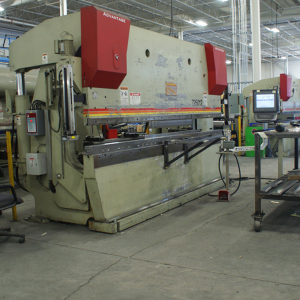
It will come as no surprise that any large-scale shop designed around metal fabricating, such as the 35,000 sq. ft facility at 4 Way Metal Fabricators, will have numerous machines at its disposal to meet certain standards of quality.
One such machine is known as the hydraulic press brake, and will be the spotlight of today’s piece.
Let’s mull over what makes this machine such a staple for all things fabrication:
What Is a Hydraulic Press Brake?
It’s no surprise to learn that when it comes to metal fabricating, sheet metal – more often than not – will have to be fashioned into a specific shape to meet the requirements of a project. It is rare for sheet metal to be incorporated in a project the same shape it was supplied in.
For such situations, the press brake is unrivalled in its function and is an essential machine across a host of industries, e.g. automotive, aircraft, housing, etc. Why is it so prominent? Well, if your fabrication project requires the bending of a metal panel, you’re going to need a press brake.
How Does a Hydraulic Press Brake Work?
From simple to complex components, this machine utilises a v-shaped die whereupon a punch from above presses the metal into shape - this force, as its name implies, is provided through a hydraulic motor.
Their operation can be broken down into the following steps:
- Hydraulic cylinders on the C-frames move the ram.
- Oil is fed into the cylinders via a flow control feed.
- Pistons within these cylinders control the movement of the ram.
The hydraulic press brakes for metal fabricating today are CNC operated, allowing for unparalleled precision while also being economical.
Benefits of a Hydraulic Press Brake
On top of the irreplaceable function they provide for metal fabricating, there are a host of rewards that fabrication shops reap from this machine:
- Adieu, Mostly, to Maintenance – a good rule of thumb within a shop is: more moving parts, more maintenance. Hydraulic press brakes are renowned for their respectively few moving parts. This means less locations of wear and replacement parts to worry about.
- Foolproofing – human-error is a factor in any work environment and should be accounted for – which is exactly what a hydraulic press brake does. Should an operator make an error and utilise the press for bending a component that requires more than the machine’s rated tonnage, the overload protection system designed within the hydraulics will prevent damage from happening, i.e. a hydraulic press brake will not go above its rated tonnage.







